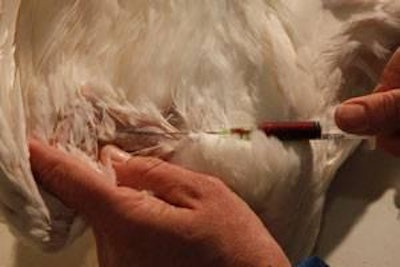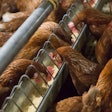
Advances in DNA sequencing technology, the chicken genome project results, and a lot of hard work by researchers and geneticists are being combined by poultry primary breeders to change the way selection is done in pedigree flocks. Research projects involving pedigree lines from poultry primary breeders are demonstrating that genomic selection can increase the rate of progress in all traits, including economically important ones. The amount of the increase will vary depending on the trait, but the consensus is that the industry will notice more rapid progress.
Dr. Neil O’Sullivan, director of research and development, Hyline International, said, “Over the course of the next decade you will be able to see that the incremental rate of genetic progress will increase.” Genomic selection works, according to Dr. Gerard Albers, director of research and technology, Hendrix Genetics, which owns ISA. “We have verified that the theoretical predictions are pretty close to reality,” he said. The consensus among the primary breeder companies is that the rate of improvement in traits will increase somewhere between 30% and 50% faster than they have historically. All traits respond positively to genomic selection, but not at the same rate.
O’Sullivan called genomic selection a paradigm shift for poultry breeders. He explained that in independent studies, egg production now increases at just a little more than three eggs per year. “With genomic selection we should go to around four eggs per hen and if we get really lucky, 4.5 eggs per hen,” O’Sullivan said.
Genomic selection benefits
Roosters don’t lay eggs, so no phenotypic information on egg laying can be gathered for males. With regard to egg production, males have been selected for use as breeders using family based selection. Data on how a male’s female relatives perform as layers was used to determine a male’s breeding value for egg laying. With family based selection, full brothers have the same breeding value assigned to them. Each brother got half of his genes from mom and half from dad, but not the same half. With genomic techniques, it is possible to select among the brothers to find the one carrying the single nucleotide polymorphisms most likely to positively affect egg laying in the progeny.
Selection for any trait that has relied on family based selection can be improved with genomic selection. “Traits like feed conversion and gain per day are relatively easy to measure for individual birds,” said Dr. Rachel Hawken, director of biotechnology, Cobb-Vantress. “But traits like improved livability can’t be measured on an individual level.”
Hawken explained that genomic selection opens new opportunities for improving the rate of progress on traits like livability. At hatch, breeding companies can place pedigree stock in “challenging environments.” Data on the performance of birds under challenging conditions would be correlated with their SNP data and this information can be used to select sires and dams from the birds raised on the pedigree farms.
How it works
Chickens have hundreds of thousands of SNPs in their genome. Phenotype information like growth rate, feed conversion and rate of lay is gathered from individuals within pedigree populations, and this is correlated with the individuals’ SNPs. With the use of statistics, an individual's SNPs can be compared to information in the database and a genomic breeding value can be assigned to the animal.
One drawback of genomic selection has been the cost of running the genetic tests. Breeders developed gene chips which tested up to 60,000 SNPs per bird, but a statistical technique, imputation, offers the potential for cost savings. Imputation allows the breeding company to test for a smaller number of SNPs and then use statistics to fill in the blanks in between. Hawken said, “We have figured out that we don’t have to do all 60,000 SNPs on every animal. We test for a smaller number of SNPs, say 3,000. The cost per test has been reduced from hundreds of dollars per test to tens of dollars per test. You lose some accuracy, but the test cost is dramatically reduced.” She said that this technique is used heavily by dairy breeders. “This has increased our ability to implement genomic selection by reducing the cost,” Hawken said.
Balancing speed and accuracy
Analysis of an individual’s SNPs can allow selection to take place earlier in the life cycle of the animal. Albers explained that every breeding program has to balance speed and accuracy of selection. For chickens, you would like to make the selection at the time of the hen’s first egg. For traits that are expressed later in life than at time of first lay, genomic selection can cut the generation time down, which speeds the rate of progress.
“In a layer program, the traits that we are concentrating on today are egg production, egg quality and life span of the birds. We have extended the performance collection period of our candidates to 100 weeks of age. We are selecting for the chicken that produces for 100 weeks and lays 500 eggs,” said Albers. With genomic selection, SNP data is correlated with good egg production out to 100 weeks. Breeder candidates are then selected at time of first egg based on how their SNPs correlate with the hens that had good late performance. In this manner, progress can be made on late egg production with each successive generation even though the candidates are selected early in the lay cycle.
Genomic selection can also improve population structures so genetic variation is maintained over time. O’Sullivan explained that genomic selection allows females to be mated to more than one male, because the genomic testing establishes the pedigree. “With the same population size there are many more birds with different relationships than in the past,” he said.
Coming soon
Pedigree birds of today will produce grandparents of commercial layers and the great grandparents of commercial broilers. It can take four or five years for advancements to work through the pipeline from pedigree to commercial farms. None of the primary breeders contacted for this article had a set date when birds whose relatives were selected at least partly based on genomic testing would arrive at their customers’ doorsteps. All breeding companies stressed that more traditional methods of selection are still being employed and that while genomic selection offers tremendous advantages, it will always be used in conjunction with other selection methods.
Given the start dates for the various genomic selection initiatives undertaken by the poultry primary breeder companies, performance curves for commercial birds could be expected to start curving upward at slightly larger angles as soon as 2012 or 2013.



















